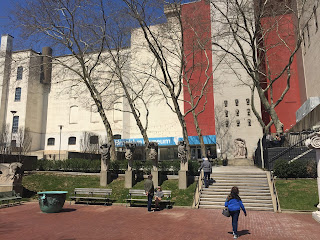Barbara Cummings
Brooklyn Museum: Black Radical Women 1965-1985
We Wanted a Revolution
Empress Akweke 1975 (Dindga McCannon)
My term final was to explore the Brooklyn Museum of which my focus of interest was focusing on the work of black women artists, We Wanted a Revolution: Black Radical Women, 1965–85 examines the political, social, cultural, and real priorities of women of color during the coming of second-wave feminism. We Wanted a Revolution: is part of A Year of Yes: Reimagining Feminism at the Brooklyn Museum, a yearlong series of exhibitions celebrating the 10th anniversary of the Elizabeth A. Sackler Center for Feminist Art. (1) The collection of African art at the Brooklyn Museum is one of the oldest and finest in the world. William Siegmann worked from 1978 to 2009 as its African art curator, this was a catalogue, published just after his retirement, features more than 130 handiworks from the collection.
Observation
During my visit I was quite impressed with a large number of the pieces of art. The pieces I enjoyed the most, was the dinner Party, and tell you why I believe this piece of art was created. The room looks of royalty and the detail of each piece show the character of the person displayed. The unique outline structure displays the outline and details of each settings was a view I will never forget, yet they can see each other within their personal spaces. The room itself was breathtaking.
| Judy Chicago (American, born 1939). The Dinner Party, 1974–79 |
The dinner party was made by Judy Chicago. She is an American feminist artist, and art educator. The dinner party is a massive ceremonial banquet, arranged on a triangular table with a total of thirty-nine place settings, each commemorating an important woman from history. (3) The settings consist of embroidered runners, gold chalices and utensils, and china-painted porcelain plates with raised central motifs that are based on vulvar and butterfly forms and rendered in styles appropriate to the individual women being honored.(3) The names of another 999 women are inscribed in gold on the white tile floor below the triangular table. (3) The picture is hard to show the elegance of each piece. The Dinner Party celebrates the accomplishments of women throughout history and is widely regarded as the first epic feminist artwork.
What captured my Interest
Committee to Defend the Black Panthers, 1970 (Cut and pasted colored paper, pencil and press-type on paper) he Museum of Modern Art, New York: The Abby Aldrich Rockefeller Endowment for prints, 2016, 236,2016
|
What really caught my attention was how the museum did an outstanding job in exhibiting the experiences and talents of the women of color. For example there were diverse groups but the were women who were feminism, political action, art production, and art history in this significant historical period. In fact one of the artist that had pieces displayed at the Brooklyn Museum was Faith Ringgold a feminist whose features quotations from important african American women such as Sojourner Truth and Harriet Tubman who'd combining language and gestural painting was to stimulate the mind about the experience of black women in the United States.
This poster was a personal guest of solidarity by Faith Ringgold which was to support the Black Panthers. To her knowing it was rejected because it had group address and phone number on it. The Group founded in 1966 for Self Defense they reached a height of it membership in 1970 when Ringgold conceived her poster. This poster was actively undermined and harred by FBI when Director J Edgar Hoover called the Panthers greatest threat to internal security of the county.
Faith Ringgold American born 1930- Acrylic on Canvas
(Courtesy of ACA Galleries, New York)
|
This pic is Ringgold blends of African American quilting techniques, Tibetan thangka painting forms, and Chisholm’s own world in a colorful tribute to her pioneering breakthrough at the intersec of gender, race, and politics. There was such wide variety of diverse group of artists and activists who lived and worked at the intersections of avant-garde art worlds, radical political movements, and profound social change, the exhibition features a wide array of work, including conceptual, performance, film, and video art, as well as photography, painting, sculpture, and printmaking.
| Dindga McCannon Revolutionary Sister, 1971 |
Dindga McCannon Revolutionary Sister, 1971 in the show “We Wanted a Revolution: Black Radical Women, 1965-1985” at the Brooklyn Museum. It display a mixed media of construction on wood. The piece has a piece which motivated her for making Revolutionary Sister: Just a few lines in Quote” In the 60’s and 70’s we didn’t have many women warriors (that we were aware of) so I created my own. Her headpiece is made from recycled mini flag poles. The shape was inspired by my thoughts on the statue of liberty; she represents freedom for so many but what about us (African Americans).........Just to a little more about artist Dindga McCannon, a harlem native born July 31, 1947, an African-American known as a quilter, author and illustrator. She knew she wanted to be an artist since she was 10. She is self-taught and works intuitively. Calling herself a "fiber artist" she works at "fusing my fine art "training" with the traditional women's needlework taught to me by my mother, Lottie K. Porter and grandmother Hattie Kilgo-sewing", beading, embroidery and quilting into what is now known as Art Quilts.[1] Her work is a celebration of women's lives, portraits. Her art is a window into "history."
(2)The Elizabeth A. Sackler Center for Feminist Art was established through the generosity of the Elizabeth A. Sackler Foundation.
(3) https://www.brooklynmuseum.org/exhibitions/dinner_party














